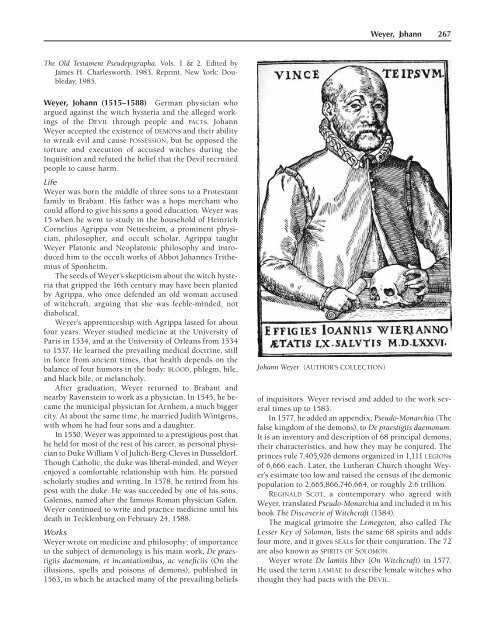The Encyclopedia Of Demons And Demonology
The Encyclopedia Of Demons And Demonology
The Encyclopedia Of Demons And Demonology
You also want an ePaper? Increase the reach of your titles
YUMPU automatically turns print PDFs into web optimized ePapers that Google loves.
Weyer, Johann 267<br />
<strong>The</strong> Old Testament Pseudepigrapha. Vols. 1 & 2. Edited by<br />
James H. Charlesworth. 1983. Reprint, New York: Doubleday,<br />
1985.<br />
Weyer, Johann (1515–1588) German physician who<br />
argued against the witch hysteria and the alleged workings<br />
of the DEVIL through people and PACTs. Johann<br />
Weyer accepted the existence of DEMONs and their ability<br />
to wreak evil and cause POSSESSION, but he opposed the<br />
torture and execution of accused witches during the<br />
Inquisition and refuted the belief that the Devil recruited<br />
people to cause harm.<br />
Life<br />
Weyer was born the middle of three sons to a Protestant<br />
family in Brabant. His father was a hops merchant who<br />
could afford to give his sons a good education. Weyer was<br />
15 when he went to study in the household of Heinrich<br />
Cornelius Agrippa von Nettesheim, a prominent physician,<br />
philosopher, and occult scholar. Agrippa taught<br />
Weyer Platonic and Neoplatonic philosophy and introduced<br />
him to the occult works of Abbot Johannes Trithemius<br />
of Sponheim.<br />
<strong>The</strong> seeds of Weyer’s skepticism about the witch hysteria<br />
that gripped the 16th century may have been planted<br />
by Agrippa, who once defended an old woman accused<br />
of witchcraft, arguing that she was feeble-minded, not<br />
diabolical.<br />
Weyer’s apprenticeship with Agrippa lasted for about<br />
four years. Weyer studied medicine at the University of<br />
Paris in 1534, and at the University of Orléans from 1534<br />
to 1537. He learned the prevailing medical doctrine, still<br />
in force from ancient times, that health depends on the<br />
balance of four humors in the body: BLOOD, phlegm, bile,<br />
and black bile, or melancholy.<br />
After graduation, Weyer returned to Brabant and<br />
nearby Ravenstein to work as a physician. In 1545, he became<br />
the municipal physician for Arnhem, a much bigger<br />
city. At about the same time, he married Judith Wintgens,<br />
with whom he had four sons and a daughter.<br />
In 1550, Weyer was appointed to a prestigious post that<br />
he held for most of the rest of his career, as personal physician<br />
to Duke William V of Julich-Berg-Cleves in Dusseldorf.<br />
Though Catholic, the duke was liberal-minded, and Weyer<br />
enjoyed a comfortable relationship with him. He pursued<br />
scholarly studies and writing. In 1578, he retired from his<br />
post with the duke. He was succeeded by one of his sons,<br />
Galenus, named after the famous Roman physician Galen.<br />
Weyer continued to write and practice medicine until his<br />
death in Tecklenburg on February 24, 1588.<br />
Works<br />
Weyer wrote on medicine and philosophy; of importance<br />
to the subject of demonology is his main work, De praestigiis<br />
daemonum, et incantationibus, ac veneficiis (On the<br />
illusions, spells and poisons of demons), published in<br />
1563, in which he attacked many of the prevailing beliefs<br />
Johann Weyer (AUTHOR’S COLLECTION)<br />
of inquisitors. Weyer revised and added to the work several<br />
times up to 1583.<br />
In 1577, he added an appendix, Pseudo-Monarchia (<strong>The</strong><br />
false kingdom of the demons), to De praestigiis daemonum.<br />
It is an inventory and description of 68 principal demons,<br />
their characteristics, and how they may be conjured. <strong>The</strong><br />
princes rule 7,405,926 demons organized in 1,111 LEGIONs<br />
of 6,666 each. Later, the Lutheran Church thought Weyer’s<br />
estimate too low and raised the census of the demonic<br />
population to 2,665,866,746,664, or roughly 2.6 trillion.<br />
REGINALD SCOT, a contemporary who agreed with<br />
Weyer, translated Pseudo-Monarchia and included it in his<br />
book <strong>The</strong> Discoverie of Witchcraft (1584).<br />
<strong>The</strong> magical grimoire the Lemegeton, also called <strong>The</strong><br />
Lesser Key of Solomon, lists the same 68 spirits and adds<br />
four more, and it gives SEALs for their conjuration. <strong>The</strong> 72<br />
are also known as SPIRITS OF SOLOMON.<br />
Weyer wrote De lamiis liber (On Witchcraft) in 1577.<br />
He used the term LAMIAE to describe female witches who<br />
thought they had pacts with the DEVIL.












